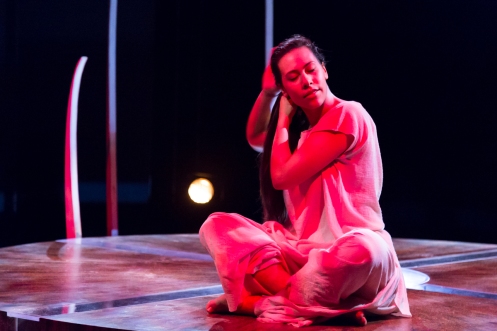Samaqani Cocahq (Natalie Sappier)
Finding Wolastoq Voice
Reviewed September 21, 2019
Azrieli Studio, Ottawa
(Repeat performances September 22 & 23, 8:00 p.m.)

Dancer Aria Evans interprets Samaqani Cocahq’s Finding Wolastoq Voice
Indigenous artist Samaqani Cocahq-Natalie Sappier (The Water Spirit) launched a compelling new piece of dance theatre in Ottawa Friday night that speaks gently but insistently of a young Indigenous (Wolastoqiyik) woman’s journey to self-love.
This gem of a work opens on a solitary note, a wavelength that washes over the theatre in a soothing, peaceful tone, slowing down the heartbeat, lengthening the breath . . . and effectively introducing us to solo dancer Aria Evans, who enters the spectacular set, created by designer Mushkegowuk Cree/European Andy Moro. A member of the creative team at the Banff Centre’s Indigenous Dance Residency, Moro has set the stage for Finding Wolastoq Voice with a large circular platform, inset with channels of water and surrounded by a lower circular trench filled with sand. His lighting washes the stage with warm, earthy tones, providing a sense of the natural world and at times one of the unseen spirit world.
And there, from the platform, we hear her intimate story. A voice narrative dominates the show, informing Evans’s actions. The words are beautifully poetic. They fall gracefully and with trust from the tongue. They take us, without shame, into the deepest soul and the vulnerable heart of the protagonist.
 Evans is pure, definitive grace, dressed in shapeless white clothing that leaves the emphasis on her gestures of remembrance, her slow deliberate movements and her innocent and hopeful facial expression. As she climbs slowly onto the platform, performing a brief ritual of wiping her feet, she brings us directly into her world. We go back to her childhood, where she recalls wanting to be a salmon.
Evans is pure, definitive grace, dressed in shapeless white clothing that leaves the emphasis on her gestures of remembrance, her slow deliberate movements and her innocent and hopeful facial expression. As she climbs slowly onto the platform, performing a brief ritual of wiping her feet, she brings us directly into her world. We go back to her childhood, where she recalls wanting to be a salmon.
She plays in the water. She becomes one with the water. She becomes the salmon, at one with its blood.
We follow her through her dark, lonely childhood, when she hears the voices of her ancestors, the old songs that awaken her from a long sleep and guide her gently through conflict, abuse, confusion, despair and inevitably to a connection to home and the waters where her ancestors gathered, and ultimately to self-love.
“I used to think I was not Indian enough,” she recites. “But I am. I am here and I’m awake now. I’ve slept for awhile but while I was sleeping I was seeing things I needed to remember. I am Indian enough . . . and when I dance, I dance with spirit . . . I am here and I have stories to tell.”
Finding Wolastoq Voice is part of the Mòshkamo arts festival, a celebration of the National Arts Centre’s first ever Indigenous theatre season. Historic as the world’s first national Indigenous theatre of its kind, the Indigenous Theatre is presenting works based on, performed or created by Indigenous artists from across Canada, sharing the stories and languages of their heritage. The 19-day Mòshkamo festival runs until September 29.

Set and lighting design by Andy Moro
Still to come (for information, see moshkamofestival.ca)
Sept 24: Niishzhoowe, a singing duet, at the Glass Thorsteinson Staircase at noon (free)
Sept 25: a land-based calligraphy workshop with Mairi Brascoupe at the Atelier Shenkman Smith at 5 p.m.
Sept 25: Performer, composer and musicologist Jeremy Dutcher of the Tobique First Nation in New Brunswick’s bold approach to forgotten Wolastoqiyik songs and stories (SOLD OUT)
Sept 25-27: Mura Buai (Everyone, Everyone), a dance production by Australian choreographer Ghenoa Gela, at the Glass Thorsteinson Staircase, at noon and 6:30 p.m. (free)
Sept 26: Innu writer Florent Vollant, who recently released his album Mitsha Meshkenu (open road), a mix of country folk and Tex-Mex flavours, at the Fourth Stage at 8:30 p.m.
Sept 26-28: Dancers of Damelahamid, an Indigenous dance company from the Northwest coast of British Columbia, presents Mînowin in the Azrieli Studio at 8 p.m.
Sept 27: Métis composer Ian Cusson’s Le loup de Lafontaine, inspired by the legend of a wolf that terrorizes an old French-speaking village in Ontario, with groundbreaking guest violinist Pekka Kuusisto performing Icelandic composer Daníel Bjarnason’s Violin Concerto, in Southam Hall at 7 p.m.
Sept 27: Nunavut’s “brooding” Josh Qaumariaq and The Trade-Offs singing the Arctic blues, a blend of Inuktitut and English lyrics, at the Fourth Stage at 8:30 p.m
Sept 28: Dancers of Damelahamid’s Margaret Grenier’s movement workshop focusing on the contemporary coastal Indigenous dance form, for all dancers aged 14 and older, in the Rossy Pavilion at 10:30 a.m.
Sept 28: An Indigenous Art Market in the O’Brien Atrium at noon (free), featuring jewelry, beadwork, mittens, moccasins and craftwork by Métis, Inuit and First Nations artists, from noon to 6 p.m.
Sept 28: Young Panniqtuq, Nunavut electropop artist Riit at the Fourth Stage at 8:30 p.m.
Sept 29: Dance, music, theatre and craft workshops and activities for families in the O’Brien Atrium throughout the afternoon, from 1 p.m. (free entry)